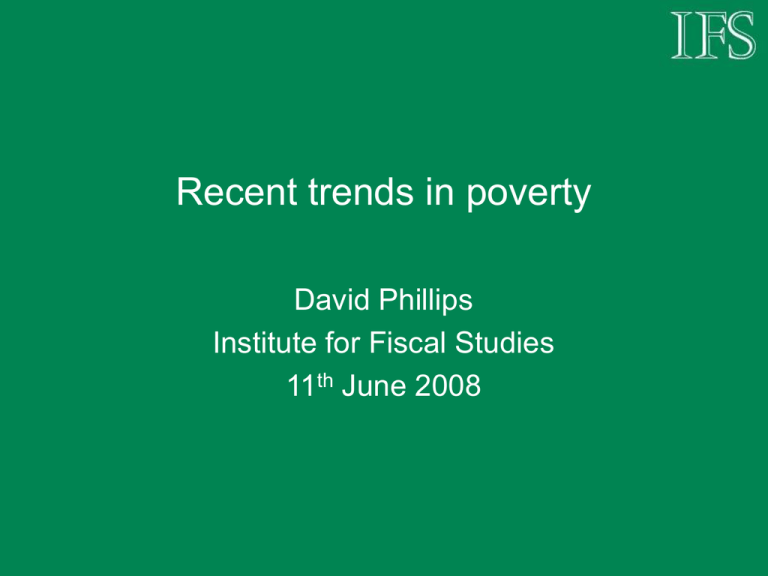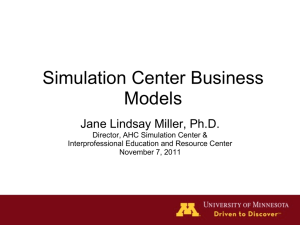Recent trends in poverty David Phillips Institute for Fiscal Studies 11
advertisement

Recent trends in poverty David Phillips Institute for Fiscal Studies 11th June 2008 What’s coming up? • Poverty fell during Labour’s first two terms • Most for pensioners and children • Longest sustained fall in poverty of recent times • Poverty rose between 2005-06 and 2006-07. • Pensioner poverty increased most (by 300,000). • Child poverty needs to fall by 300,000 a year for 4 years to meet 2010-11 targets. Defining Poverty for HBAI • GB up to 2001-02, UK from 2002-03 • Focus on rates rather than numbers • Relative notion of poverty • Individuals in households below 60% of the contemporary BHC and AHC median • No account of depth of poverty Poverty fell in Labour’s first two terms 30% 25% 20% 15% 10% 5% 0% 1979 1984 1989 60% AHC Median 1994 1999 2004 60% BHC Median Source: HBAI Data (FES and FRS) Poverty rose in 2005-06.. 30% 25% 20% 15% 10% 5% 0% 1979 1984 1989 60% AHC Median 1994 1999 2005 60% BHC Median Source: HBAI Data (FES and FRS) ..And again in 2006-07 30% 25% 20% 15% 10% 5% 0% 1979 1984 1989 60% AHC Median 1994 1999 60% BHC Median Source: HBAI Data (FES and FRS) 2006 Across all thresholds? 1996-97 Rate 70% of AHC Median 60% of AHC Median 50% of AHC Median 40% of AHC Median 31.9 25.3 16.9 8.8 Source: HBAI Data (FRS) Across all thresholds? 70% of AHC Median 60% of AHC Median 50% of AHC Median 40% of AHC Median 1996-97 Rate 31.9 25.3 16.9 8.8 Labour 1 Change -1.8 -2.1 -1.6 (-0.3) Source: HBAI Data (FRS) Across all thresholds? 70% of AHC Median 60% of AHC Median 50% of AHC Median 40% of AHC Median 1996-97 Rate 31.9 25.3 16.9 8.8 Labour 1 Change -1.8 -2.1 -1.6 (-0.3) Labour 2 Change -1.8 -2.6 -1.9 (-0.2) Source: HBAI Data (FRS) Across all thresholds? 70% of AHC Median 60% of AHC Median 50% of AHC Median 40% of AHC Median 1996-97 Rate 31.9 25.3 16.9 8.8 Labour 1 Change -1.8 -2.1 -1.6 (-0.3) Labour 2 Change -1.8 -2.6 -1.9 (-0.2) Change in 2005-06 +0.8 +1.1 +1.0 (+0.4) Source: HBAI Data (FRS) Across all thresholds? 70% of AHC Median 60% of AHC Median 50% of AHC Median 40% of AHC Median 1996-97 Rate 31.9 25.3 16.9 8.8 Labour 1 Change -1.8 -2.1 -1.6 (-0.3) Labour 2 Change -1.8 -2.6 -1.9 (-0.2) Change in 2005-06 +0.8 +1.1 +1.0 (+0.4) Change in 2006-07 +0.4 +0.6 +0.7 +0.7 Source: HBAI Data (FRS) Across all thresholds? 70% of AHC Median 60% of AHC Median 50% of AHC Median 40% of AHC Median 1996-97 Rate 31.9 25.3 16.9 8.8 Labour 1 Change -1.8 -2.1 -1.6 (-0.3) Labour 2 Change -1.8 -2.6 -1.9 (-0.2) Change in 2005-06 +0.8 +1.1 +1.1 (+0.5) Change in 2006-07 (+0.4) (+0.6) (+0.7) +0.6 29.5 22.2 15.2 9.4 2006-07 Rate Source: HBAI Data (FRS) Across all thresholds? 70% of AHC Median 60% of AHC Median 50% of AHC Median 40% of AHC Median 1996-97 Rate 31.9 25.3 16.9 8.8 Labour 1 Change -1.8 -2.1 -1.6 (-0.3) Labour 2 Change -1.8 -2.6 -1.9 (-0.2) Change in 2005-06 +0.8 +1.1 +1.0 (+0.4) Change in 2006-07 +0.4 +0.6 +0.7 +0.7 2006-07 Rate 29.5 22.3 15.3 9.5 Labour-to-Date -2.4 -3.0 -1.7 +0.6 Source: HBAI Data (FRS) Growth in Benefit Entitlements Non-working Couple, 3 kids 3.1% Non-working Lone Parent, 1 kid 2.7% Part-time working Lone Parent, 1 kid 3.0% Single Adult on Job Seekers Allowance 2.2% Single Adult on Incapacity Benefit 2.7% Single Pensioner on Pension Credit 4.2% Basic State Pension 2.7% Poverty Line (AHC) 3.6% RPI Inflation 3.7% Composition of Poverty (AHC) 30% 25% 20% 15% 10% 5% 0% 1979 1984 1989 1994 1999 2006 Children Working Age (with Children) Working Age (without Children) Pensioners Source: HBAI Data (FES and FRS) and authors’ analysis Child Poverty • 2004-05 Target • Cut number of children in poverty by ¼ compared with 1998-99 • Narrowly missed • 2010 Target • Cut child poverty by ½ compared with 1998-99 • Looks very challenging. 2010 target looks very challenging Children (Millions) 3.5 3 2.5 2 1.5 1998 2000 2002 2004 1998-99 2010-11 Target Progress to date Required path 2006 2008 2010 Child poverty Source: HBAI Data (FRS) and authors’ analysis 2010 target looks very challenging Children (Millions) 3.5 3 2.5 2 1.5 1998 2000 2002 2004 2006 2008 2010 Child poverty Progress to date Required path Projected poverty in 2010 Source: HBAI Data (FRS) and authors’ analysis For whom has child poverty risen? • Focus on number of children in poverty (BHC) • Look at 125,000 rise between 2004-05 and 2006-07 • Can decompose the rise in child poverty into: • A changing risk for specific family types • The changing composition of families with children Decomposing the 125,000 rise in child poverty since 2004-05 -75000 -50000 -25000 0 25000 50000 75000 100000 125000 150000 175000 Lone Parents Full-time Part-time Workless All Lone Parents Couples with children Self-employed Two FT One FT, One PT One FT One or Two PT Workless All couples with children All children Composition Effect Risk Effects Total Change Source: HBAI Data (FRS) and authors’ analysis 200000 Pensioner poverty 45% 40% 35% 30% 25% 20% 15% 10% 5% 0% 1980 1985 1990 Pensioners AHC 1995 2000 Pensioners BHC Source: HBAI Data (FES and FRS) 2006 Pensioner poverty rises 45% 40% 35% 30% 25% 20% 15% 10% 5% 0% 1980 1985 1990 Pensioners AHC 1995 2000 Pensioners BHC Source: HBAI Data (FES and FRS) 2006 Pensioner Poverty • Pensioner Poverty up by 200,000 AHC and 300,000 BHC. • First time it has risen AHC since 1996-97 • First time it has risen BHC since 2001-02 • The rise is statistically significant and sizeable. • Undoes about 1/6 of AHC fall since 1996-97 • About 2/3 of the BHC fall. • Poverty risk up for all age groups (particularly older). • IFS researchers predicted a rise but not this big. • Supporting evidence from other surveys. Factors underlying the rise • Abolition of additional age-related payments • Rising inflation eroded the value of benefits. • Fall in benefit receipts captured in survey. • But there was a rise in the private incomes of pensioners in 2006-07 Factors underlying the rise • Abolition of additional age-related payments • Payments of £50 or £200 in Winter 2005 not repeated. • Added 100,000 to pensioner poverty. • Rising inflation eroded the value of benefits. • Fall in benefit receipts captured in survey. • There was a rise in the private incomes of pensioners in 2006-07 Factors underlying the rise • Abolition of additional age-related payments • Rising inflation eroded the value of benefits. • The State Pension fell in real terms in 2006-07. • Fall in benefit receipts captured in survey. • There was a rise in the private incomes of pensioners in 2006-07 Factors underlying the rise • Abolition of additional age-related payments • Rising inflation eroded the value of benefits. • Fall in benefit receipts captured in survey. • Could be partly under-recording of certain benefits (e.g. the Pension Credit). • There was a rise in the private incomes of pensioners in 2006-07 Factors underlying the rise • Abolition of additional age-related payments • Rising inflation eroded the value of benefits. • Fall in benefit receipts captured in survey. • But there was a rise in the private incomes of pensioners in 2006-07 • Mostly private pensions, with some investment income and employment income. Working-age adults without dependent children 20% 15% 10% 5% 0% 1980 1985 1990 60% of AHC Median 1995 2000 60% of BHC Median Source: HBAI Data (FES and FRS) 2006 Absolute poverty falls up to 2004-05 40% 35% 30% 25% 20% 15% 10% 5% 0% 1979 1984 1989 60% AHC Median 1994 1999 60% BHC Median Source: HBAI Data (FES and FRS) 2004 Rises in 2005-06 and 2006-07 40% 35% 30% 25% 20% 15% 10% 5% 0% 1980 1985 1990 60% AHC Median 1995 2000 60% BHC Median Source: HBAI Data (FES and FRS) 2006 Summing up • • • • Relative poverty rise Second year in a row for poverty rise. Still lower than its 1996-97 level Pensioner poverty rose the most • 100,000 due to the abolition of age-related payments • Need to find new money to achieve 2010 target • Difficult with tight government finances.






